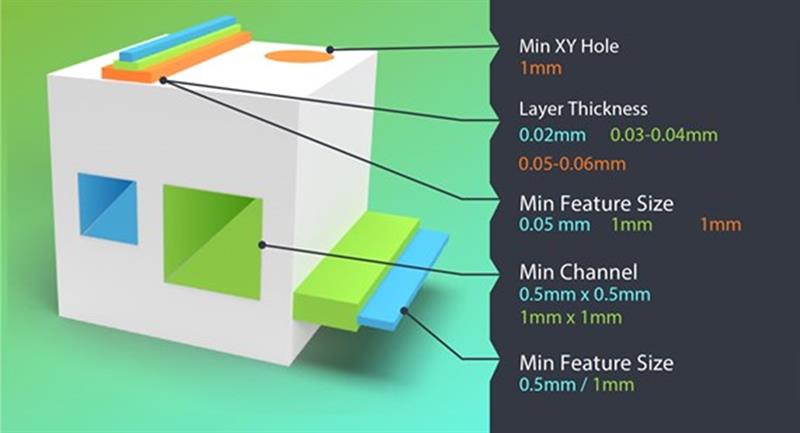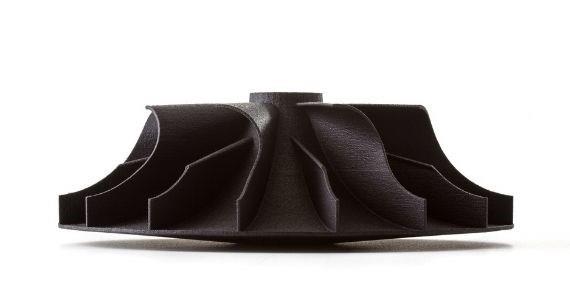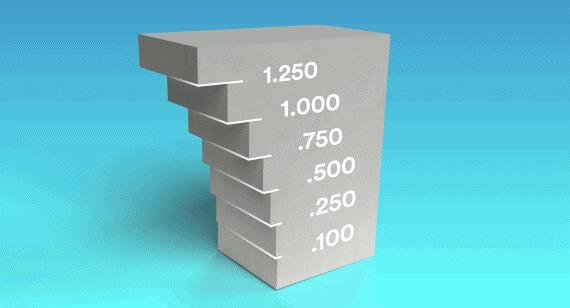So, we asked our applications engineers to compile a list of troublesome issues they frequently see in the CAD models that are destined for 3D printing, and tips to solve those issues. Here are seven common mistakes to avoid to help you improve the manufacturability of your 3DP designs and shorten run times.

In this illustration, the blue/teal colour represents micro resolution (MR), green is high resolution (HR), and orange is normal resolution (NR). Also, the minimum channel and minimum Z dimensions apply to both NR and HR.
1. Avoid Too-Large or Too-Small Feature Sizes for Certain Processes, Materials
This is a prime issue, which you’ll see emerge across several additive methods. Keep in mind that there are some geometries that will allow for exceptions so feel free to consult with one of our applications engineers with questions.
DMLS
Wall thicknesses in metal 3D printing can be tricky and differ, depending on metal material selection, orientation, and resolution. Cobalt Chrome, Titanium and Stainless steel require a wall thickness of at least 0.5mm. Wall thickness for all other metals is 1mm.
For other metals, the absolute minimum feature size (for positive features—those that are solid or dense) is thickness of 0.2mm - 0.3mm with a height of 0.5mm. This is the minimum feature size the laser will draw. This does not mean that every feature designed at this thickness will form or survive post-processing. This minimum applies to well-designed features that fall in the draw plane (x, y) such as walls or features that are vertical.
Hole-size capabilities depend on the depth of the hole and resolution. Typically, holes less than 1mm will be susceptible to sealing shut or coming smaller than designed. For holes smaller than 1mm consider high resolution.
SIZING UP FEATURES | |
| | DMLS | SLA | |
| MINIMUM SIZES: POSITIVE FEATURES | Micro Resolution (MR):
0.5mm High Resolution (HR):
1mm
Normal Resolution (NR):
1mm | Micro Resolution (MR):
0.07mm
High Resolution (HR):
0.13mm
Normal Resolution:
0.25mm | |
| MINIMUM SIZES: NEGATIVE SPACES (HOLES, SLOTS, CHANNELS, GAPS) | 0.5mm | Holes:
0.5mm Channels:
0.6mm Slots:
0.4mm | |
SLA
SLA’s dimensional accuracy and high surface quality make it a reliable choice for high-fidelity projects. However, orientation will play a role with feature formation. Knowing these minimums based on build orientation will help you better design parts for additive.
Holes with a diameter less than 0.5mm will be susceptible to sealing shut during build. Internal channels should be at least 0.5mm and slots should be 0.4mm . If a model requires holes less than 0.5mm, or a slot less than 0.4mm, consider our Micro Resolution material, offered in MicroFine™ Green and Grey. In SLA, we offer three resolutions: normal, high, and micro (MR).
Minimum feature size for SLA? SLA technology provides one of the best feature resolutions in the industry. Features as small as 0.07mm in MR 0.13mm in HR, and 0.25mm in NR can. This feature resolution can only be obtained in the draw plane (x, y) so features like supported walls, inset, and embossed features (think 3D-printed micro molds). The wall thicknesses are different in the build direction where the minimum feature size is 0.4mm in both NR and HR and 0.2mm in MR in the z plane. Keep in mind the longer/taller the thin features are the more thickness it will require to survive
3D-Printed Nylons
For 3D-printed nylon parts, listed below are three important issues we often see on those parts that need to be addressed in the CAD model. Common geometries that can be problematic include blind holes, threads, and areas where internal diameters and tapers are in too close proximity to exterior walls.
Wall Thickness: This refers to the thickness in any direction on part walls or geometries. The minimum allowable wall thickness is 0.8mm in SLS and 0.5mm in MJF.
Channel Gaps: This refers to the distance between two features. Channel gaps are important to consider when designing for 3D-printed nylons because the sintering process can fuse two features together that do not account for channel gaps. We recommend minimum channel gap sizes of 0.8mm for both SLS and MJF.
Knife Edging: Consider designs that have an inset feature, such as a counter-bored hole. Your dimension may drop below the minimum feature size at the distal end of the hole. This could result in a shortened or round feature that does not properly form.

Be wary of warpage, as seen in this MJF example. The thinner a part is and the closer it is overall to the minimum feature size, the more likely it is to warp.
2. Avoid Low-Resolution STL Files
In some cases, we receive STL files that are low resolution, which results in coarse faceting (surfaces similar to gemstone). Low-resolution files with coarse faceting will not prevent us from manufacturing the part, but it could affect the aesthetics of the part. Most CAD modeling software allows you to adjust your STL resolution in your export settings. Reducing tolerance usually has the greatest effect and improves resolution. We recommend that you ensure your STL’s are high resolution (not so large that they can’t be uploaded or manipulated 100MB or less) or submit a STP/STEP file that we can convert to STL on our end.
Beyond STL files, we accept native SolidWorks (.sldprt) or ProE (.prt) files as well as solid 3D CAD models from other CAD systems output in IGES (.igs), STEP (.stp), ACIS (.sat) or Parasolid (.x_t or .x_b) format.
3. Prevent Part Warpage in SLS and MJF Parts
Powder-based printing processes like SLS and MJF use heat to sinter powder together into a solid part. The heat that builds the parts can also lead to undesired part warpage. Again, part size and overall thickness has the largest impact on part warping potential. The larger the part—200mm and above being particularly difficult—the more likely the part is to warp. The thinner a part is and the closer it is overall to the minimum feature size, the more likely it is to warp. We recommend four options if you are concerned warpage may be an issue for your design.
- Make the part close to the uniform thickness of 3mm to help ensure stability.
- Opt for a glass-filled nylon, like PA 12 40% glass-filled (SLS material).
- If your part is above 200mm and you are concerned about warpage, another option is to run an unfilled nylon material in our large frame SLS machine with build extents of 736mm x 635mm x 533mm.
- A final option is to print the part in our larger format stereolithography (SLA) machines, which have build extents as large as 736mm by 635mm by 533.4mm.
4. Avoid Differential Shrink in SLS, MJF
Similar to part warpage, differential shrink can occur when a part has unequal distribution of material. When one side of the part is exceptionally thick compared to the rest of the part, this causes the part to thermally cool at different rates. The thicker parts will cool much slower than the thin areas, and this can lead to undesired part shrink.
If a thick feature is required on the part, we recommend hollowing the feature to a shell of approximately 3mm. If possible, match the overall thickness of your part to the large feature’s shell thickness.

When designing for DMLS, be cautious about overhangs—abrupt changes in a part’s geometry. As seen in this example, if the next layer is larger than the previous layer, it will create an overhang. DMLS is fairly limited in its support of overhangs.
5. Avoid Large Overhangs for DMLS Parts
Metal 3D printing has its own set of design issues, yet one common item that often emerges involves overhangs. Different from self-supporting angles that offer a smooth slope to a part design, overhangs are abrupt changes in a part’s geometry. DMLS is fairly limited in its support of overhangs when compared to other 3D printing technologies like stereolithography and selective laser sintering. Any overhang greater than 0.8mm should have additional support to prevent damage to the part. When designing overhangs it is wise to not push the limits as large overhangs can lead to reduction in a part’s detail and worse, lead to the whole build crashing.
6 Don't Choose the Wrong Material for SLA Parts
Today’s SLA machines use a range of thermoplastic-like materials, with several options to mimic polypropylene, ABS, and polycarbonate available. However, please note the term “thermoplastic-like.” This is an important distinction in that the mechanical properties of SLA materials only mimic those of their moulded counterparts. SLA parts do not provide the same strength and durability as parts that are sintered, cast, machined, or molded. That said, SLA is still an excellent choice for quality prototype parts where validation of form and fit—but not necessarily function—is the most important factor. Our applications engineers can help guide you during material and manufacturing process selection if help is needed.
7. Ensure 3D-Printed Elastomeric Parts are Suitable for Overmoulding
Next, caution is advised around elastomers for 3D printing. PolyJet, uses a special type of “sprayable” liquid photopolymer with a hardness that can be tweaked on the fly and in the same build. This process makes it a great choice for prototyping parts that will at some point be overmoulded—a soft, grippable handle for a power tool, for example, or a weatherproof, gasketed cover for a scientific instrument housing. In addition, digital photopolymers in white, black, and clear/translucent are available.
Accordingly, if you want to validate an overmould design, this is probably a good place to start. However, and this is where the caution comes in—be sure to check with one of our applications engineers that your 3D-printed part is also suitable for moulding. Some designers get caught in a jam with a particular part design, only to find that it can’t be manufactured en masse in a cost-effective manner. More information can be found in our elastomers design tip and at our overmolding and insert molding services page.
We know we covered a lot of 3D printing territory here, but as always, feel free to contact us with any questions at +44 (0) 1952 683047 or customerservice@protolabs.co.uk.